The two-week trip from SD to AZ and our summer geo/camping excursions 'taught' us we enjoyed the trip and adventure more if every two days or so, we took a break from strenuous/serious caching and geocached in a community or took a road trip. We are following that guideline when in Tucson. Friday and Saturday were desert caching days with 'stressful to me' roads. On Sunday we chose to geocache in downtown Tucson. (Monday was back in the desert and home on Tuesday.)
Our first stop was a geo event, outdoors in a park. The hosts furnished donuts. I found it challenging to drink coffee and eat a donut while wearing a mask, but I did it without embarrassing myself too much!
my Christmas jelly-filled roll
Then it was off to the University of Arizona campus, Wildcat country.
The science-themed art display above the entrance to the new chemistry building caught my eye. (Click on the photo to enlarge it for a closer look at the different disciplines taught in this building.)
Then it was off to the El Presidio, the fortification built by the Spanish in the 18th century. This original fort became founding structure for the city of Tucson.
This Mormon Battalion Monument statue is in the plaza. Designed by Clyde Ross Morgan, the monument is a 2-ton, 19-foot-tall bronze statue of battalion members Christopher Layton and Jefferson Hunt raising the U.S. flag and engaging in peaceful trade with Teodoro Ramirez, a prominent Tucson merchant. It was dedicated in 1996.
The plaza grounds have been in use since 1539. In 1775, Captain Hugo O'Conor selected a piece of land on the east side of the Santa Cruz River for a presidio. Over the next eight years adobe walls were built to enclose the area to protect people inside the fort from Apache attacks. In 1810, a Spanish garrison of about 300 military used the park. The park as it is today was developed in 1970-71. The plaza covers 2.75 acres and contains veterans' memorials, a small rose garden, a fountain and various art pieces.
It was also the gathering for many of Tucson's homeless.
The Pima County Courthouse flanks the eastern side of the El Presidio Park. It was built in 1929 and is considered one of Tucson's iconic structures.
The mosaic-tiled dome adds to the beauty of the Mission Revival style and Spanish Colonial Revival style structure designed by Roy Place. It is now the former county courthouse and houses offices and museums. It is currently closed on the weekends.
This crested saguaro is on the grounds of the Pima County Courthouse. The yard was fenced and gated, so I could not enter for a better angled photo.
It was lunch time so we headed back to the camper to eat and watch Miss W in the church Christmas program.

Streaming the virtual concert was so slow on the computers, we resorted to watching it on my phone. Not ideal, but we will watch it again now that it has been uploaded to the church's web page.
We went back downtown to complete a few more geocaches on the Presidio grounds.
I was disappointed to learn the presidio museum is not original, although some parts of the grounds are original. The buildings look original, but are not.
The Presidio a San Agustin del Tucson was originally built by Spanish soldiers during the 18th century. Later, the fortress was taken over by the United States army and used during the American Indian Wars. The original fortress was dismantled in 1918, but was reconstructed in 2007. The items found during the reconstruction are now on display throughout the museum.
This may be one of the five original Sonoran row style homes built in the 1860s.
The red door and neat grounds caught my eye before I knew what business it housed.
it is a pub and restaurant
If we go back to the area, I will definitely pay more attention to the five original homes on the 33 acres of the Presidio Historic District.













No comments:
Post a Comment
Thanks for your comments!